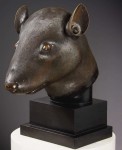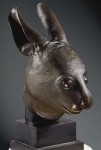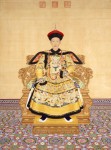 The vicissitudes of the bronze rat and rabbit heads looted from the Summer Palace by Anglo-French troops in 1860 and offered for sale at the epic Yves Saint Laurent and Pierre Bergé auction in February 2009 will come to an unexpected end later this year with their repatriation to China. François-Henri Pinault, husband of Salma Hayek and billionaire CEO of Kering, the holding company that owns such luxury brands as Gucci, Saint Laurent Paris and, not coincidentally, Christie’s, agreed to return the bronze sculptures during a diplomatic visit to China where he was one of a phalanx of businessmen accompanying French President François Hollande.
The vicissitudes of the bronze rat and rabbit heads looted from the Summer Palace by Anglo-French troops in 1860 and offered for sale at the epic Yves Saint Laurent and Pierre Bergé auction in February 2009 will come to an unexpected end later this year with their repatriation to China. François-Henri Pinault, husband of Salma Hayek and billionaire CEO of Kering, the holding company that owns such luxury brands as Gucci, Saint Laurent Paris and, not coincidentally, Christie’s, agreed to return the bronze sculptures during a diplomatic visit to China where he was one of a phalanx of businessmen accompanying French President François Hollande.
 There’s no precise date for the handover, but Pinault said it would be done in the second half of the year. The rat and rabbit will be given as a gift to China from the Pinault family, he took pains to stress, so as to avoid any appearance that this was an official decision by Christie’s corporate overlords.
There’s no precise date for the handover, but Pinault said it would be done in the second half of the year. The rat and rabbit will be given as a gift to China from the Pinault family, he took pains to stress, so as to avoid any appearance that this was an official decision by Christie’s corporate overlords.
The 2009 auction of the heads was highly controversial. The rat and rabbit were once part of a clepsydra (a water clock) in the garden of the Old Summer Palace near Beijing. Heads of the twelve animals of the Chinese zodiac mounted on human bodies served as water spouts, each head spouting water for a designated two-hour period. Designed by an Italian Jesuit missionary, Giuseppe Castiglione, who took the name Lang Shining  and became an important painter and artist at the court of Qianlong Emperor (1736-1795), this section of the palace and gardens blended Western and Chinese styles. The fountain clock adorned the entrance to the Hall of Calm Seas (Haiyantang) palace, built in 1759, which was a masonry palace inspired by the Grand Trianon at Versailles.
and became an important painter and artist at the court of Qianlong Emperor (1736-1795), this section of the palace and gardens blended Western and Chinese styles. The fountain clock adorned the entrance to the Hall of Calm Seas (Haiyantang) palace, built in 1759, which was a masonry palace inspired by the Grand Trianon at Versailles.
By the time of Qianlong Emperor’s death, the European art and architecture trend in China was passé. In 1795, the pipeworks were melted down so it no longer functioned as clock or fountain, but the external design was untouched; the heads and every other visible part of it remained in place. That would end in 1860 courtesy of the Second Opium War.
 On September 29, 1860, two envoys from the French and British expeditionary forces and their escort, who were in the town of Tung-Chow outside Beijing to negotiate a truce, were imprisoned and tortured. Apparently there had been some sort of scuffle between a French officer and some Chinese soldiers, and General Sang-ko-lin-sin ordered the whole Anglo-French party arrested. Although the two envoys and 14 of their escort survived, 20 died in a most brutal fashion.
On September 29, 1860, two envoys from the French and British expeditionary forces and their escort, who were in the town of Tung-Chow outside Beijing to negotiate a truce, were imprisoned and tortured. Apparently there had been some sort of scuffle between a French officer and some Chinese soldiers, and General Sang-ko-lin-sin ordered the whole Anglo-French party arrested. Although the two envoys and 14 of their escort survived, 20 died in a most brutal fashion.
The British and French were furious. The envoys had been under a flag of truce, so arresting and savaging them was a violation of custom and law. They saw it as a form of extortion, an attempt by the Chinese to strengthen their negotiating position by kidnapping. If it was, it backfired dramatically.
In retaliation, and to deter any future notions of kidnap and torture as negotiating tools, the British High Commissioner to China, also eighth Lord Elgin and the son of the despoiler of the Parthenon marbles, ordered that the Summer Palace be destroyed. The complex was by then populated only by a handful of eunuchs and servants and although there were Imperial troops in the environs, they weren’t about to rush in to protect the old pile. Foreign troops had already begun to loot it before the envoys were released; Elgin took it to a whole new level, saying, “What remains of the Palace, which appears to be the place at which several of the British captives were subjected to the grossest indignities, will be immediately levelled to the ground.”
Charles George Gordon, who would later become a famous martyr of British imperialism after his beheading in the Siege of Khartoum, was there as a 27-year-old volunteer with the Royal Engineers. He had just arrived in China in September and was among the troops dispatched by Elgin to do the deed. In a letter home, he described the destruction of the palace:
“We accordingly went out, and after pillaging it, burned the whole place, destroying, in a vandal-like manner, most valuable property, which could not be replaced for four millions. We got upward of £48 apiece prize money…I have done well. The people are very civil, but I think the grandees hate us, as they must after what we did the Palace. You would scarcely imagine the beauty and magnificence of the places we burnt. It made one’s heart sore to burn them; in fact, these palaces were so large, and we were so pressed for time, that we could not plunder them carefully. Quantities of gold ornaments were burned, considered as brass. It was wretchedly demoralising work for an army. Everybody was wild for plunder.”
 The grandees definitely hated them, and the people weren’t exactly fans either. They still harbor massive resentment over these events, and the destruction of the Summer Palace has become a symbol of how European powers despoiled and humiliated China. Today what’s left of the palace is a heritage park, and Chinese buyers public and private have spent tens of millions of dollars at auctions attempting to reclaim the bronze zodiac heads and the national pride they represent. The state-owned Poly Group purchased the ox (Christie’s, 2000, $78.98 million), tiger (Sotheby’s, 2000, $35.98 million) and monkey (Christie’s, 2000, $1.03 million) and put them on display in the Poly Art Museum. Macau and Hong Kong casino billionaire Stanley Ho bought the boar (Sotheby’s, 1987, $770,000) and donated it to the Poly Art Museum. In 2007, he bought the horse for $8.9 million from a Taiwanese collector who had bought it from Sotheby’s London in 1989 for $400,000. He donated that one to the Capital Museum in Beijing.
The grandees definitely hated them, and the people weren’t exactly fans either. They still harbor massive resentment over these events, and the destruction of the Summer Palace has become a symbol of how European powers despoiled and humiliated China. Today what’s left of the palace is a heritage park, and Chinese buyers public and private have spent tens of millions of dollars at auctions attempting to reclaim the bronze zodiac heads and the national pride they represent. The state-owned Poly Group purchased the ox (Christie’s, 2000, $78.98 million), tiger (Sotheby’s, 2000, $35.98 million) and monkey (Christie’s, 2000, $1.03 million) and put them on display in the Poly Art Museum. Macau and Hong Kong casino billionaire Stanley Ho bought the boar (Sotheby’s, 1987, $770,000) and donated it to the Poly Art Museum. In 2007, he bought the horse for $8.9 million from a Taiwanese collector who had bought it from Sotheby’s London in 1989 for $400,000. He donated that one to the Capital Museum in Beijing.
There are only two other heads known to have survived: the rat and rabbit. The remaining five — dragon, dog, snake, sheep and rooster — have never surfaced on the market or been published or publicly acknowledged in any way. That’s not to say they aren’t out there somewhere, but if they did make it, they’re deep undercover.
This is why when the last two bronze heads were put up for auction, there was an immediate hue and cry. The Chinese government lodged a protest. A group of Chinese lawyers attempted to halt the sale but had no legal grounds since the pieces have been circulating on the market since they were pillaged. Pierre Bergé, Yves Saint Laurent’s longtime companion and owner of the incredible collection that ultimately sold for almost half a billion dollars, offered to give them to China free of charge if China agreed to “give in return human rights, the liberation of Tibet, and a welcome for the Dalai Lama.” China, needless to say, was not amused and chose to decline the offer.
The auction went ahead and the rat and rabbit ostensibly sold for $20 million apiece to a phone buyer. That buyer soon revealed himself to be Cai Mingchao, a Chinese collector and auctioneer who had no intention of paying for the pieces. It was a protest purchase and he insisted the bronzes should be given to China on moral principle.
I thought at the time that Christie’s would contact the runner-up and sell it for the next highest bid, but apparently Bergé just decided to keep them. At some point between the auction’s end and today, Pinault apparently bought the rat and rabbit heads. There are no specifics on when he purchased them or how this was transacted.
We do know that China immediately hit Christie’s with sanctions, drowning them in complex paperwork requirements that in addition to choking sales also made it clear to Chinese buyers that the government was not pleased with Christie’s, so it would probably be best to avoid them if you wanted to stay in its good graces.
Today, however, relations are much thawed. Downright toasty, in fact, seeing as Christie’s was granted a license earlier this month allowing it to operate independently on the Chinese mainland, the first international auction house so honored. Pinault himself is also deeply involved in doing business in China, which is flush with new money and a taste for the luxury and retail brands Kering owns. I wonder if he called up Bergé a month ago and threw him a few tens of millions of dollars to secure the sweetest of hostess gifts in time for his trip to China.
And thus a hope expressed by Victor Hugo in November of 1861 (pdf) has come to pass.
One day two bandits entered the Summer Palace. One plundered, the other burned. […] All the treasures of all our cathedrals put together could not equal this formidable and splendid museum of the Orient. It contained not only masterpieces of art, but masses of jewelry. What a great exploit, what a windfall! One of the two victors filled his pockets; when the other saw this he filled his coffers. And back they came to Europe, arm in arm, laughing away. Such is the story of the two bandits.[…]
Before history, one of the two bandits will be called France; the other will be called England. […]
The French empire has pocketed half of this victory, and today with a kind of proprietorial naivety it displays the splendid bric-à-brac of the Summer Palace. I hope that a day will come when France, delivered and cleansed, will return this booty to despoiled China.